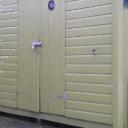Yahoo Answers is shutting down on May 4th, 2021 (Eastern Time) and beginning April 20th, 2021 (Eastern Time) the Yahoo Answers website will be in read-only mode. There will be no changes to other Yahoo properties or services, or your Yahoo account. You can find more information about the Yahoo Answers shutdown and how to download your data on this help page.
Trending News
In naval architecture, how is the size and speed of rotation of a ship's propeller determined?
9 Answers
- rookethorneLv 61 decade agoFavorite Answer
The size is determined from the power output of the engine, the type of gearbox used and the physical size of the ship.
In order to keep cavitation or 'propeller slip' to a minimum the diameter of the propeller must be as large as possible to fit beneath the hull.
The pitch of the propeller, or the amount of twist each blade has is calculated on the amount of shaft horsepower available.
In most modern naval ships propeller speeds are usually around the 150 - 220 rpm mark max. depending on the type of propeller used i.e straight or skewed blades - fixed or variable pitch.
- YnotLv 61 decade ago
Large ships, cruise liners, freighters, oil tankers etc have relatively slow turning propellers and literally screw their way through the water. The ships forward speed is the pitch of the propeller times the propeller rotational speed times a factor to allow for propeller inefficiency (usually around 97%).
As the propeller screws its way through the water it creates a low pressure on its front surface and a high pressure on its rear surface (just like a wood screw), and this gives the propeller its forward thrust. The propeller thrust is a function of its pitch, the number of blades, its diameter, and its rotational speed.
The Naval Architect calculates how much thrust is necessary to sail at full speed (This is a function of the submerged surface area of the hull and the size of the bow wave), and selects a suitable propeller or propellers accordingly.
- Anonymous1 decade ago
In modern ships the speed of the propeller is constant and the engine is run at maximum torque when the ship is accelerating or decelerating and the most efficient speed when the ship is at constant speed. The propellers are of variable pitch, so the blades rotate around the centerline with gears in the hub. To go astern the pitch is reversed, so reversing gears or a reversing engine is not required in a diesel engined or turbine ship. Steam piston engines can be designed to run backwards.
When a ship is accelerating from rest the pitch of the propeller is gradually increased to match the speed of the vessel and vice versa when it slows done.
The speed of rotation is chosen depending on engine characteristics, efficiency and practical difficulties such as avoiding cavitation where localized areas of low pressure causes water to vaporise with the bubbles damaging the propellor. Reduction gear boxes are used but you can't change gear with a big engine. The forces just become to great.
- Robert ALv 51 decade ago
There is a phenomena called cavitation where if the pressure is too low at the suction end of a propeller, vapour bubbles form and then collapse causing pitting and vibration damage to the propeller. The size must be sufficiently large and the speed of rotation sufficiently low, whilst giving the necessary thrust, for this not to occur.
- How do you think about the answers? You can sign in to vote the answer.
- Anonymous5 years ago
Man, that is really funny. Curious, how would having a shorter day bring an end to the war in Iraq? And only ole Dick Cheney would invent a 23 hour clock, maybe needs to go hunting with some buddies to get his head straight?
- 1 decade ago
by the size of propeller and and torch speed and pitch to the propeller
Source(s): me - Anonymous1 decade ago
BY THE NAVAL ARCHITECT,THE TYPE OF VESSEL ITS FOR ,WHETHER ITS FOR CRUISING OR BUILT FOR SPEED AND WHETHER THE OWNER WANTS TO FACTOR IN ECONOMY,MOST LARGE SHIPS RUN MORE THAN ONE PROPELLER NOW FOR GREATER MANOEUVRABILITY




